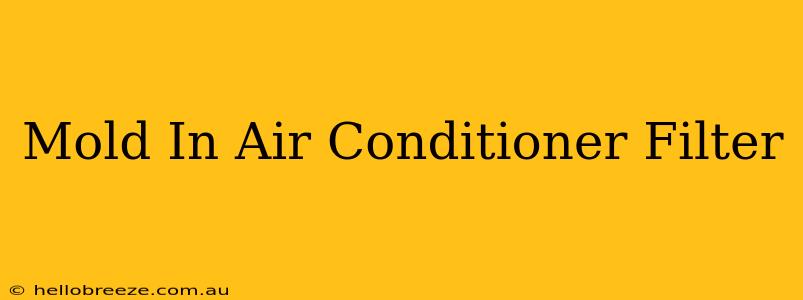Is that musty smell coming from your air conditioner a sign of something more sinister? It might be mold growing in your air conditioner filter. This isn't just an unpleasant odor; it's a potential health hazard that needs immediate attention. This comprehensive guide will help you understand the dangers of mold in your AC filter, how to identify it, and most importantly, how to prevent and remove it.
Understanding the Problem: Why Mold Grows in AC Filters
Your air conditioner filter is a breeding ground for mold for several reasons:
- Moisture: The AC unit naturally produces condensation, providing the perfect environment for mold spores to thrive.
- Dust and Debris: Accumulated dust, pet dander, and other particles provide a food source for mold growth.
- Lack of Cleaning: Neglecting regular cleaning allows mold to take root and proliferate rapidly.
Mold growth isn't just unsightly; it can significantly impact your indoor air quality and your health.
Health Risks Associated with AC Filter Mold
Inhaling mold spores can trigger a range of health problems, particularly for those with allergies or respiratory conditions like asthma. Symptoms can include:
- Allergies: Sneezing, coughing, runny nose, itchy eyes
- Respiratory Issues: Wheezing, shortness of breath, chest tightness
- More Severe Reactions: In some cases, severe mold exposure can lead to more serious health complications.
It's crucial to address mold growth promptly to protect your health and the well-being of your family.
Identifying Mold in Your Air Conditioner Filter
Identifying mold isn't always straightforward. Look for these telltale signs:
- Visible Mold: You might see fuzzy, black, green, or gray growth on the filter.
- Musty Odor: A persistent musty smell emanating from the AC unit is a strong indicator.
- Increased Allergy Symptoms: If you experience a sudden increase in allergy symptoms when the AC is running, mold could be the culprit.
If you suspect mold, don't delay taking action.
How to Clean and Replace Your Air Conditioner Filter
Cleaning or replacing your AC filter is a vital step in preventing mold growth and improving your indoor air quality. Follow these steps:
- Turn Off the AC Unit: Always disconnect the power supply before handling the filter.
- Remove the Filter: Locate the filter access panel and carefully remove the filter.
- Inspect the Filter: Check for signs of mold, dust buildup, and other debris.
- Clean or Replace:
- For washable filters: Gently clean the filter with warm water and mild detergent. Rinse thoroughly and allow it to air dry completely before reinstalling.
- For disposable filters: Replace the filter with a new one. This is often the easiest and most effective solution.
- Clean the Surroundings: Wipe down the area around the filter to remove any accumulated dust and debris.
Recommended cleaning frequency: Aim to clean or replace your air conditioner filter every 1-3 months, or more frequently if you notice excessive dirt buildup or a musty odor. Consult your AC unit's manual for specific recommendations.
Preventing Mold Growth in Your Air Conditioner
Prevention is key to avoiding mold problems. Here are some helpful tips:
- Regular Cleaning: Establish a routine of regularly cleaning or replacing your AC filter.
- Proper Ventilation: Ensure adequate ventilation in your home to reduce humidity levels.
- Address Leaks Promptly: Fix any leaks or water damage around your AC unit as soon as possible.
- Use a Dehumidifier: In humid climates, using a dehumidifier can help to lower the moisture level in your home.
By following these guidelines, you can significantly reduce the risk of mold growth in your air conditioner filter and create a healthier home environment.
Conclusion: Breathe Easier with a Clean Air Conditioner
Mold in your air conditioner filter is a serious issue that shouldn't be ignored. By understanding the causes, identifying the signs, and taking proactive steps to clean and maintain your filter, you can ensure clean, healthy air for yourself and your family. Don't let a simple filter become a significant health hazard. Take action today!

